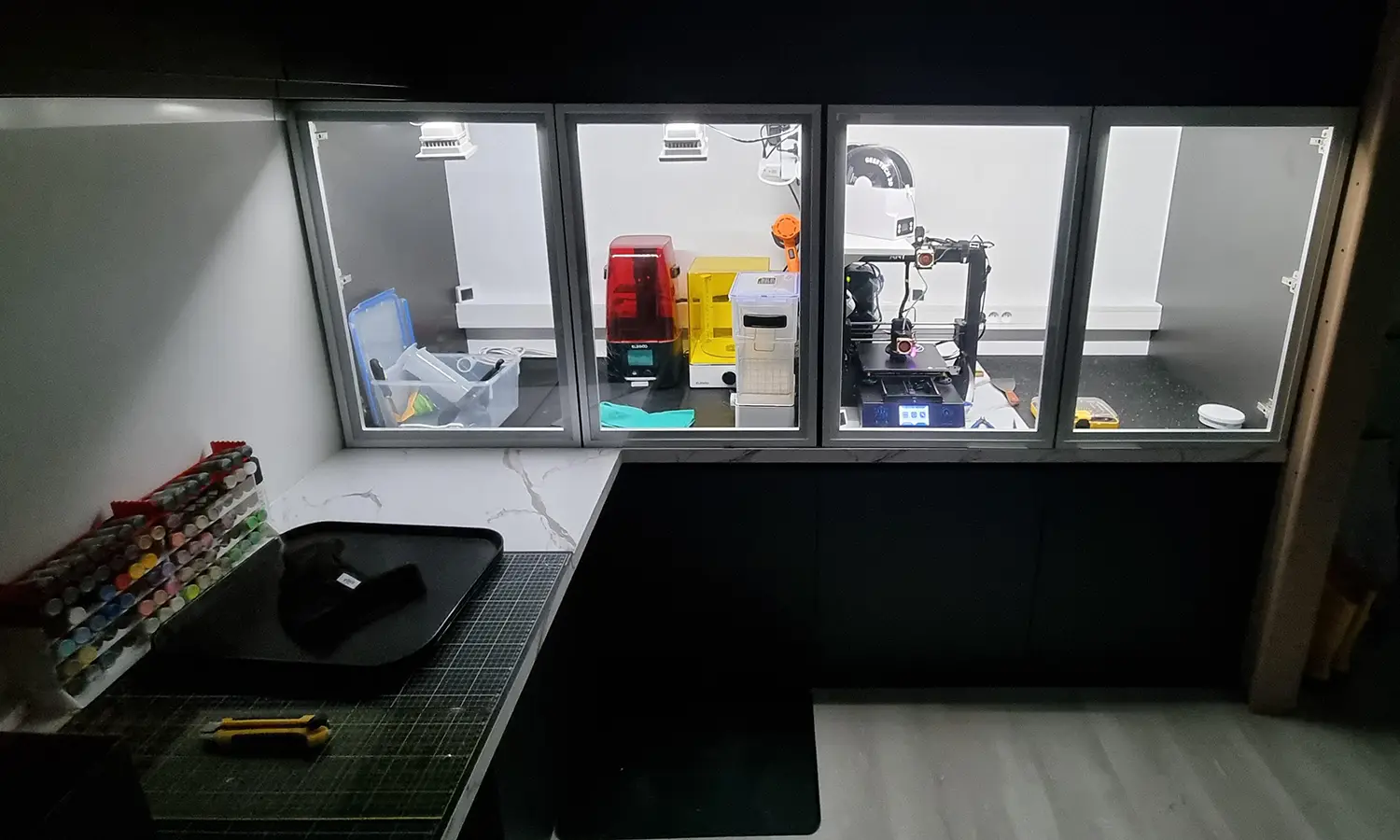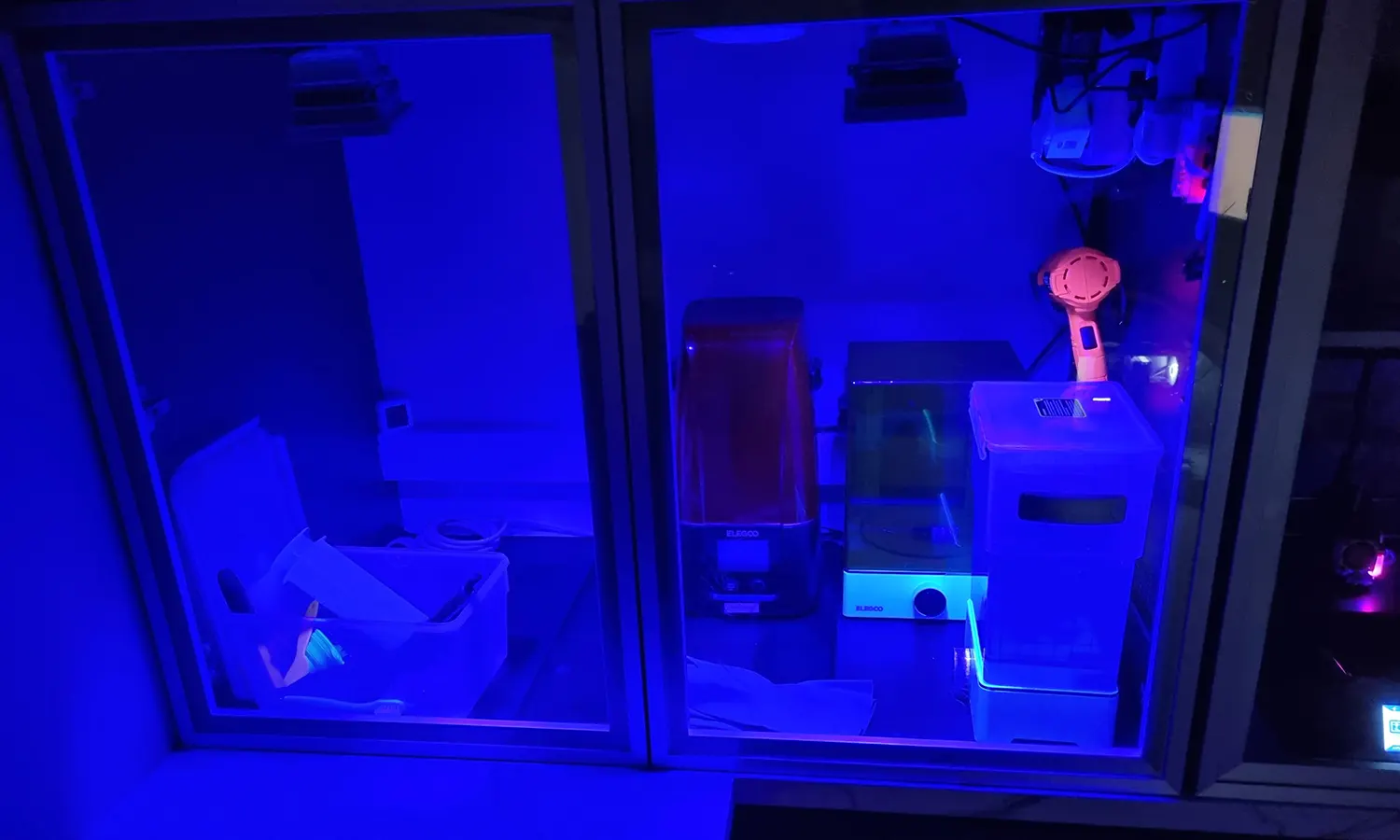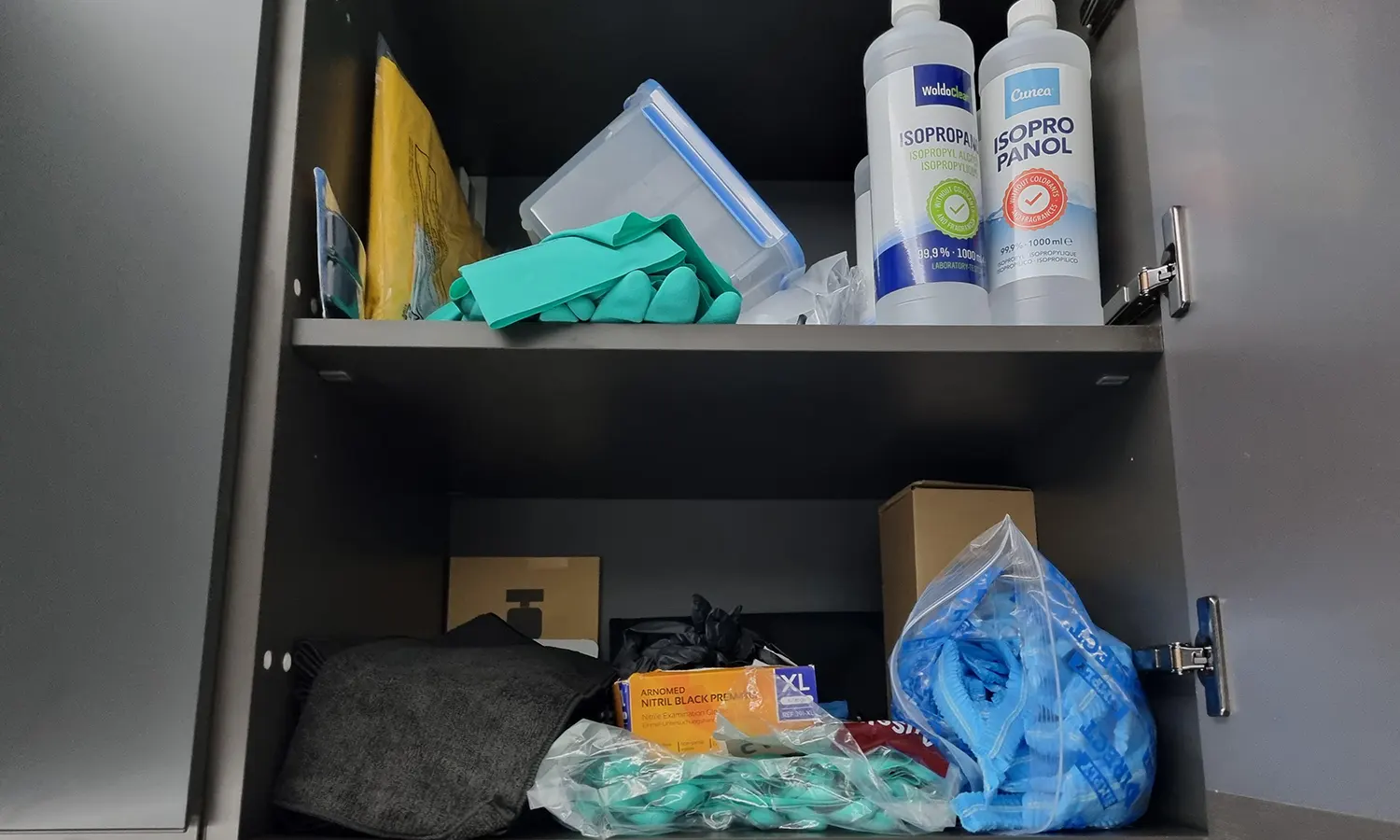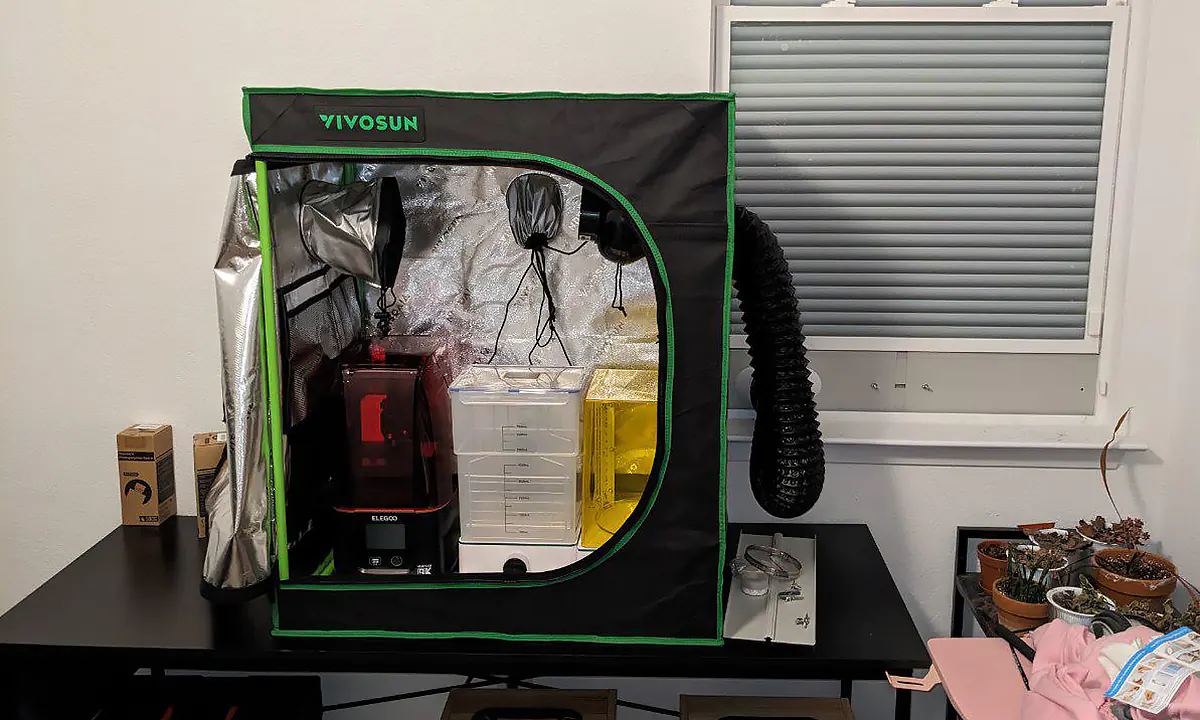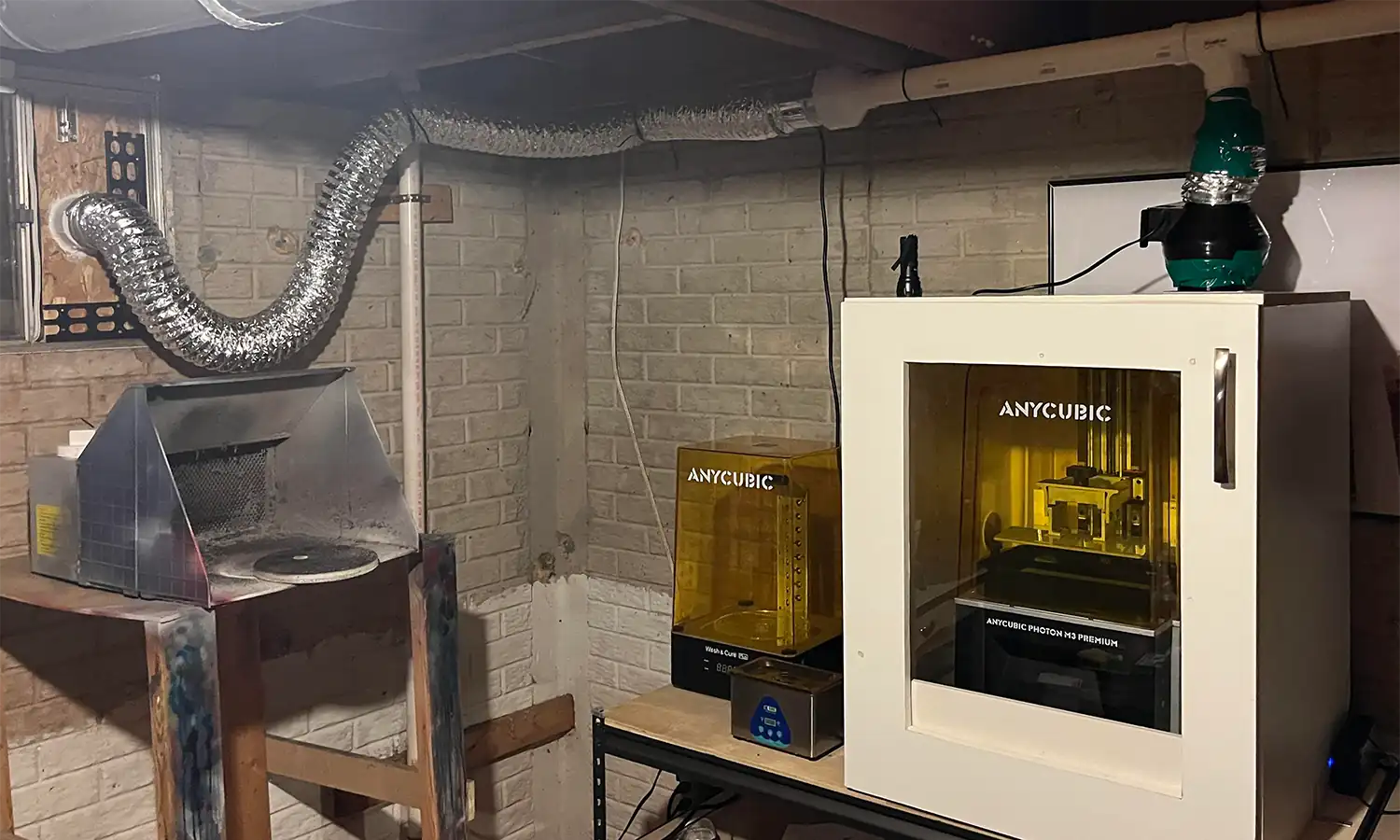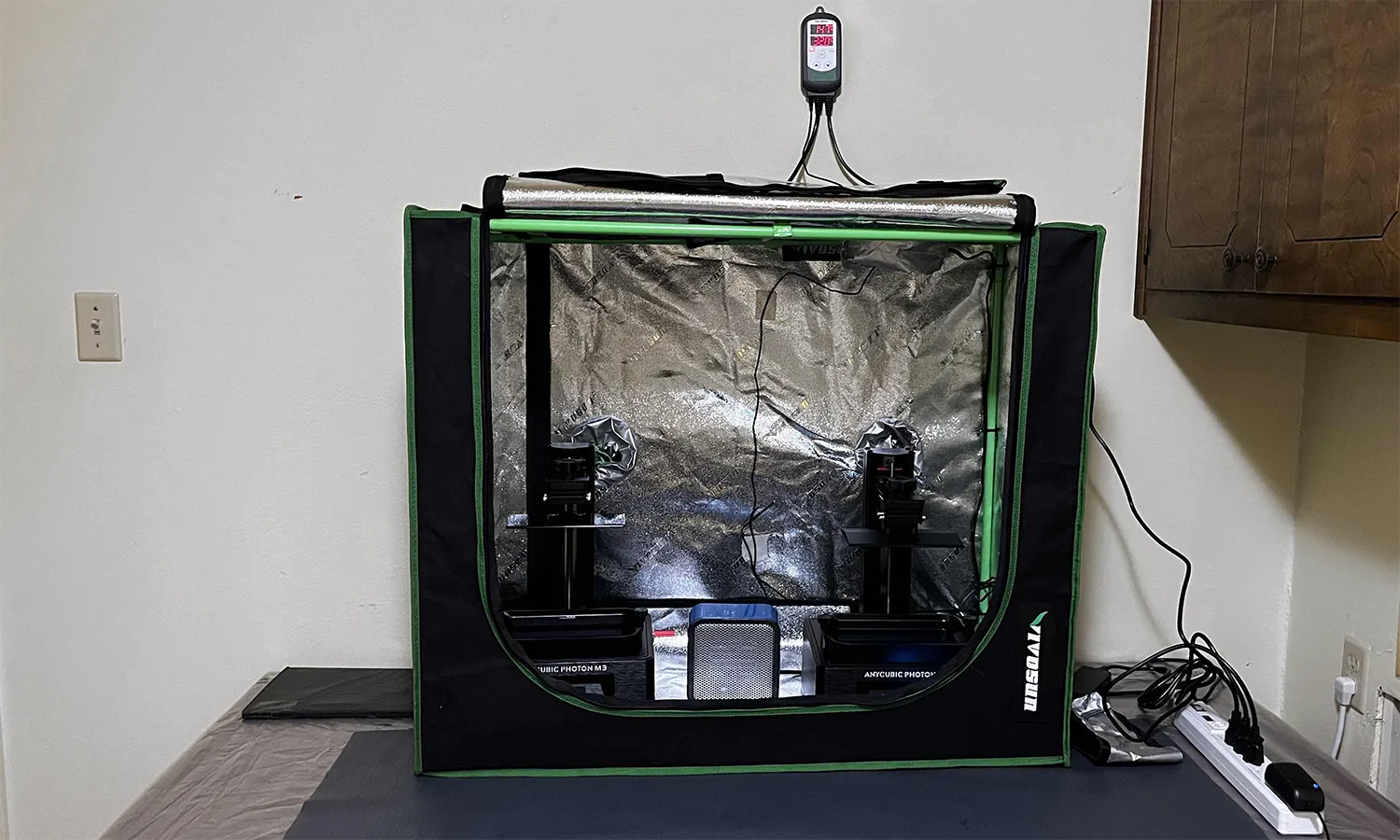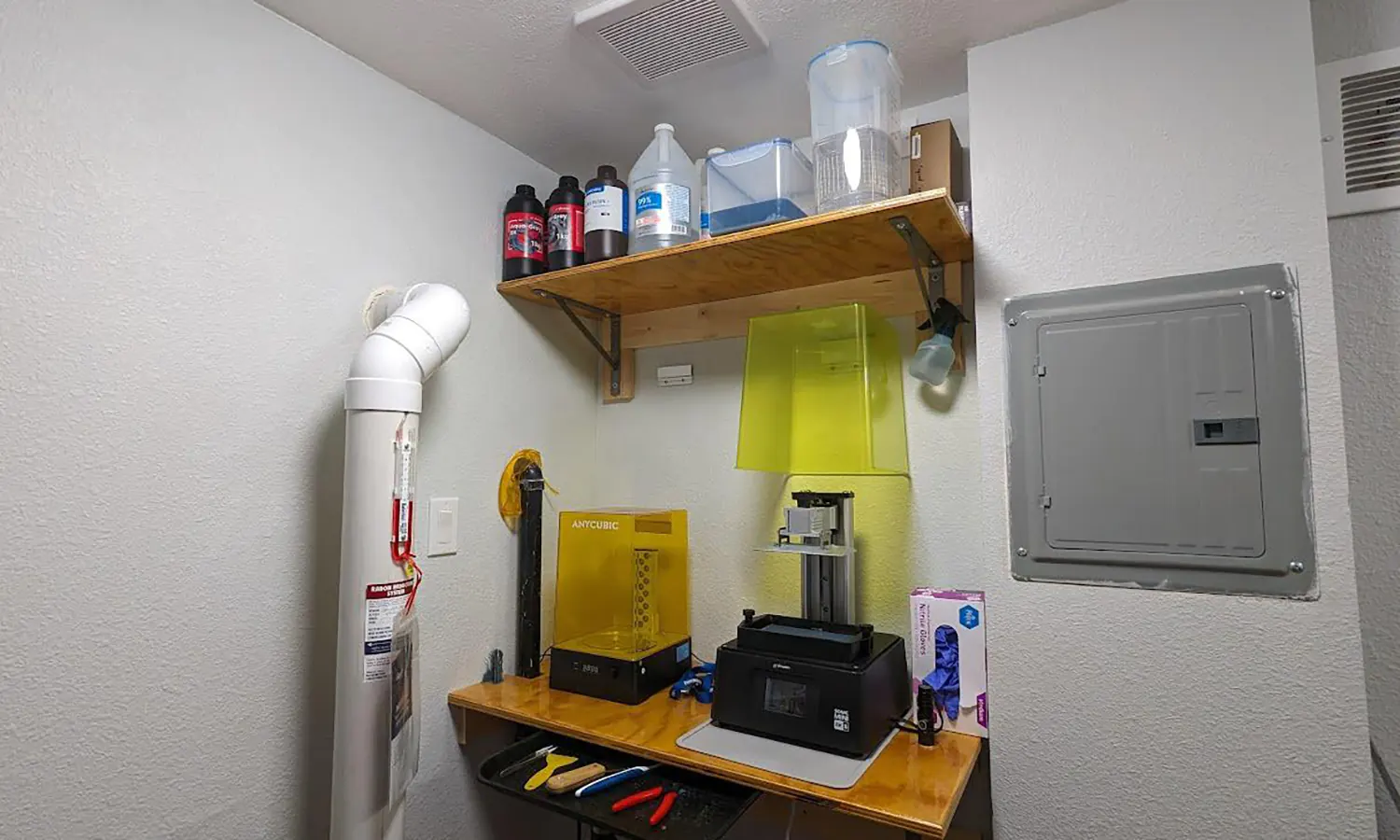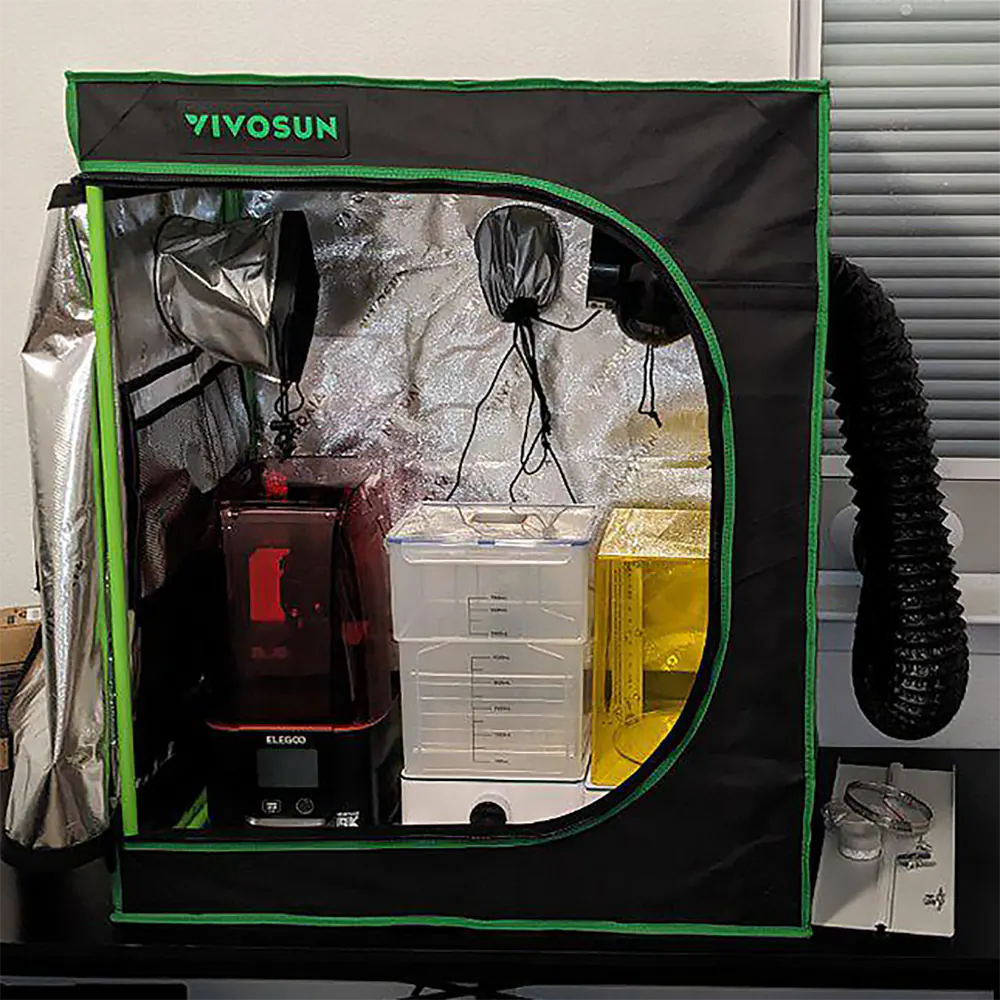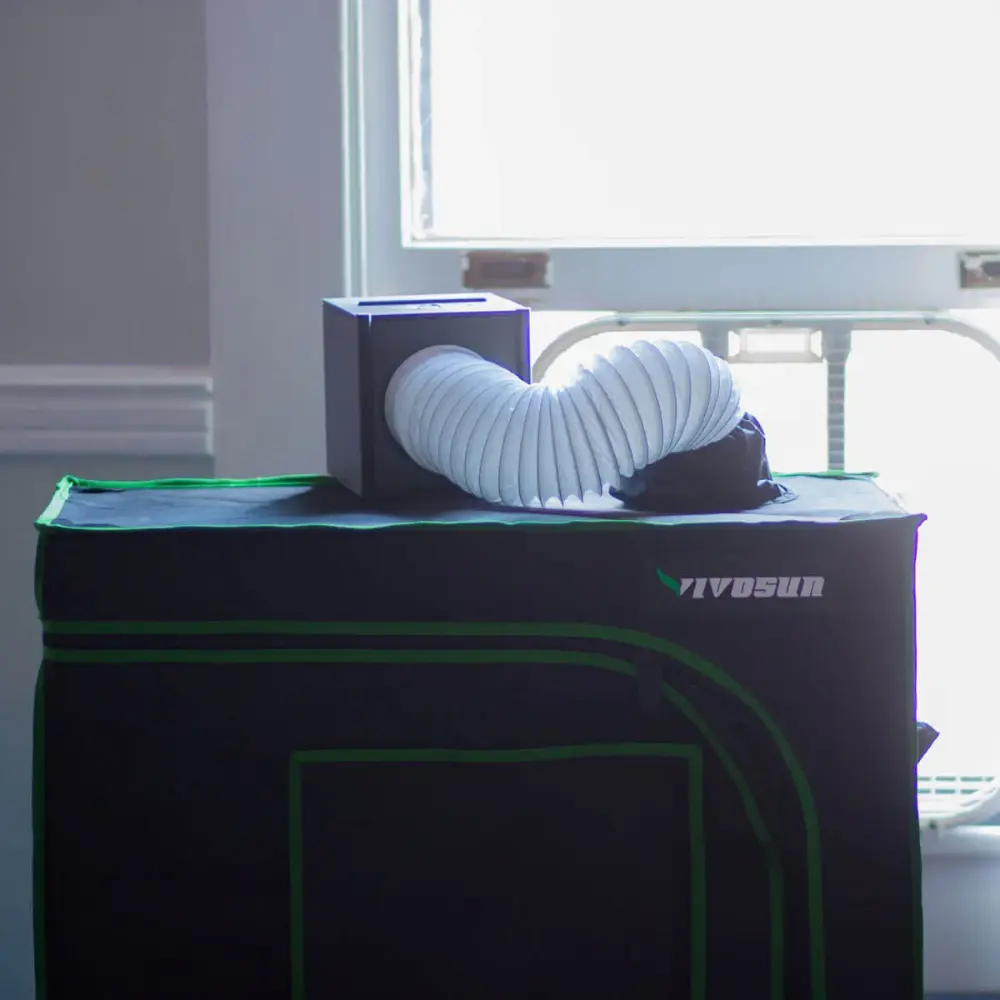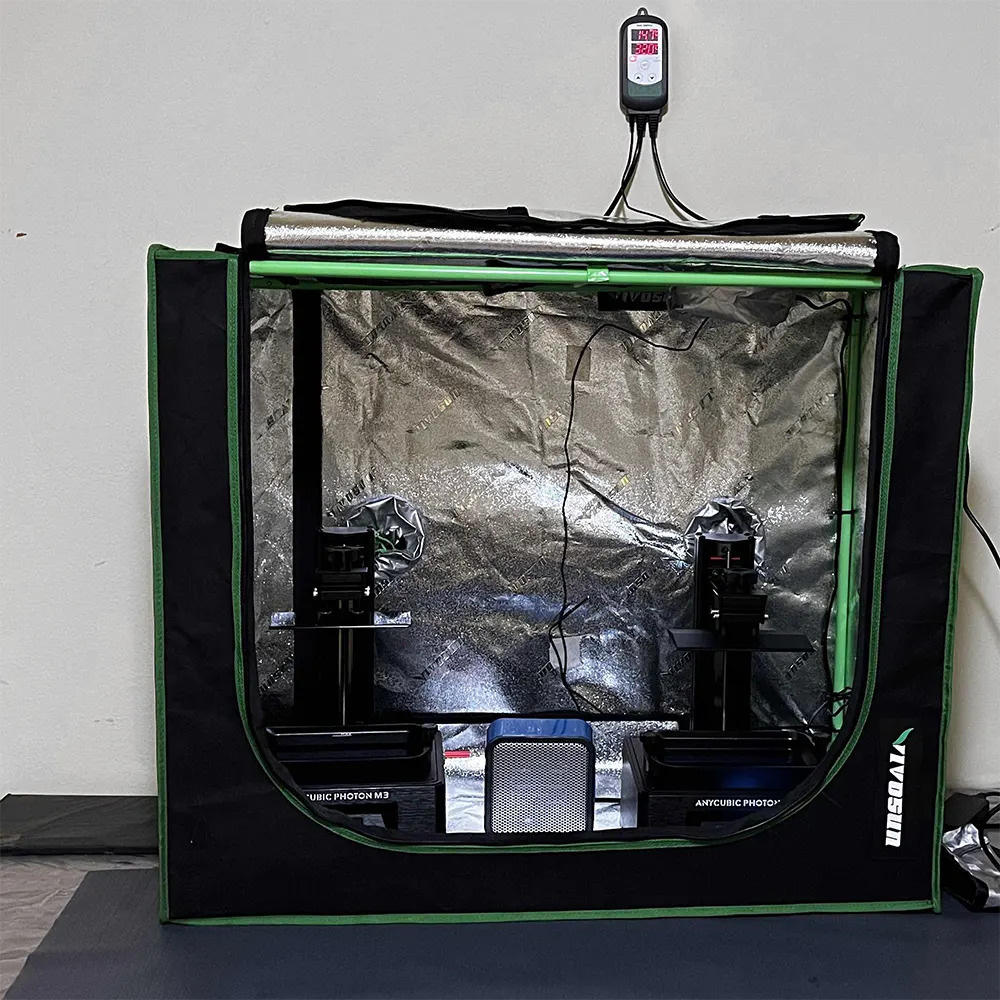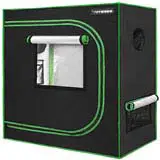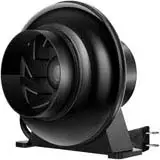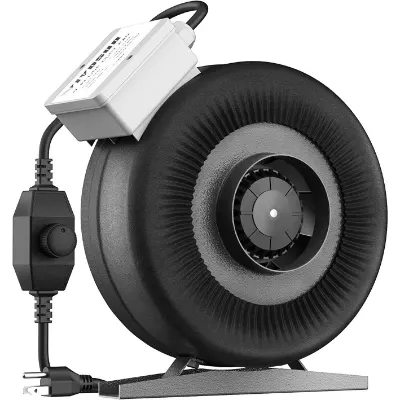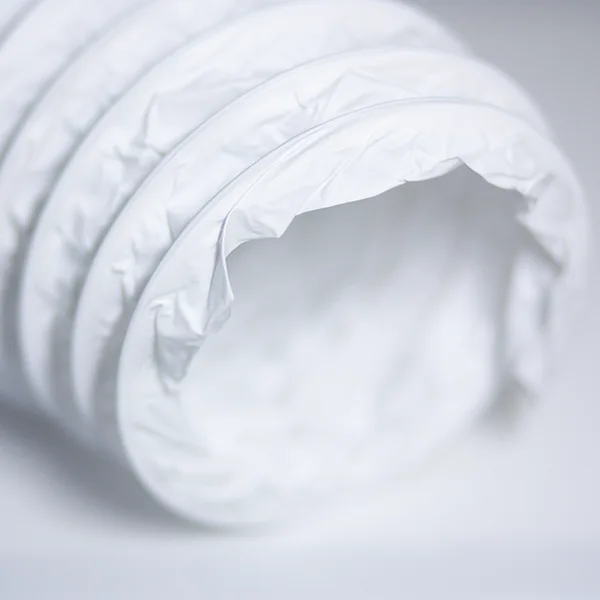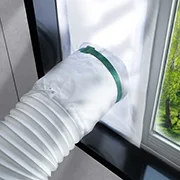The recommended method for venting a resin printer is to enclose it in a grow tent and vent the fumes outside. Flexible duct and an inline fan will connect the grow tent to a window adapter.
Ideally, the resin printer would be placed outside the house in a garage, shed, or detached room. Resin printers can be indoors but they should be enclosed and continuously vented while operating.
Table of Contents
Outdoor Resin Printer Ventilation
Garages and workshops are two of the best locations for a resin printer
It is recommended to place resin printers outside the residence. This mitigates any long-term health risks associated with the resin chemicals off-gassing. This location could be a garage, shed, workshop, balcony, or patio.
If your workspace is well vented, like a garage that has good airflow, then you can leave your resin printer and equipment on a table without an enclosure. When a printing session concludes, you can vent the garage while you are cleaning.
If your workspace is not well ventilated, then it is recommended to place the resin printer in an enclosure, like a grow tent, so you can control the ventilation. Additionally, a grow tent is recommended when heating a resin printer.
Workshop Resin Printer Setup
Double click or tap to go full screen, pan around 360°, and select the outlined items to learn more.Indoor Resin Printer Ventilation
Ventilation is a requirement when resin printers are placed inside your house
Resin printers inside your house should be placed in a separate and sealed room. The resin printer should be put in an enclosure like a grow tent. These are fairly affordable, easy to set up, and are sturdy.
Flexible duct will connect your enclosure to a window adapter. The window adapter can be made from materials like fabric, rigid plastic (for portable AC units), plywood, Styrofoam insulation, acrylic, or polycarbonate. Carboard works in a pinch but should be upgraded. If you do not have a window then consider drilling a hole in the wall to run duct.
An inline fan will pull contaminated air from the enclosure and force it outside.
Resin Printers In Apartments or Dorms
Enclose the printer and vent out a window using duct and a fan
Resin printing while living in an apartment is possible, especially if you have windows that open, a patio, or a balcony. An apartment follows the same recommendations as in a house; the contaminated air has to be vented.
It is often asked if the resin printer can be placed in an apartment's bedroom or kitchen. Putting a resin printer where you sleep is a long-term health risk, and putting it in the kitchen can contaminate your food.
If you are in student living, such as a dorm, we do not recommend getting a resin printer. Dorms often have no method of ventilation and any complaints, at minimum, could force you to get rid of the printer. Instead, it is likely that your university library or city makerspace will have printers for you to use.
Community Resin Setups
Submit your awesome 3D printer setup!
These are excellent community examples to provide some inspiration in creating your setup.
Email entries to [email protected] or on discord in the #showcase channel. We prefer the images to be landscape and at minimum 1,500x900 px. Try to capture the essence of your setup in a single photo. If you have an exceptional setup that needs multiple photos, we'll use multiple slots or create a small slideshow.
Resin Printing Grow Tent Enclosures
Grow tents are ideal for resin printers to contain heat and vent
The reasons why grow tents are widely used in resin printing is that they are affordable, easy to set up, and sturdy.
A 30 x 18 x 36 inch grow tent costs between $70 to $100. It can comfortably fit a small or medium resin printer, a heater, resin, and cleaning equipment. This size can fit two printers, but it will be cramped with a heater.
Always make sure to check the printer's dimensions and pick an appropriate grow tent. If you have the space, a larger grow tent can be useful to store multiple printers, cleaning equipment, resin, and other supplies.
- outdoors to block wind, sun, rain, and critters on a patio or balcony
- indoors to vent directly outside
- in a garage to help contain heat and optimize venting
- with a fume extractor before being vented
- to fit a printer + a wash & cure station if wide enough
- as a fume hood if using a strong inline fan
Resin Printing Ventilation Fans and Duct
How our resin room uses ventilation and fans
When it is summer and the temperature outside is ~25-35°C (77-95°F):
- We keep our resin printers outside of their enclosure and on the table.
- On high speed, our inlet fan brings clean air in through one of our Promethean air cleaners (only a MERV 13 filter). This reduces dust in the room.
- On high speed, our outlet fan vents the entire room before, during, and after printing.
When it is summer and the temperature outside is ~40°C+ (104°F):
- We keep our resin printers outside of their enclosure and on the table.
- A portable AC window unit is put on low to medium in order to cool the room.
- If on, at low speed, our inlet fan brings clean air in through one of our Promethean air cleaners (only a MERV 13 filter). This reduces dust in the room.
- On low speed, our outlet fan vents the entire room during printing.
- Both the inlet and outlet fans are turned on high when printing has concluded and cleaning has begun. Afterwards, the fans are left on high, and the AC unit is turned off.
When winter is coming and the temperature outside is below ~20-25°C (68-77°F):
- We keep our resin printers inside a grow tent and the heater temperature set to ~30°C.
- On low speed, our inlet fan brings clean air in through one of our Promethean air cleaners (only a MERV 13 filter). This reduces dust in the room.
- On low speed, our outlet fan vents the entire room during printing.
- Both the inlet and outlet fans are turned on high when printing has concluded and cleaning has begun. Afterwards, the fans are left on high, and the heater is turned off.
When installing the ventilation fans, if the total flow rate of the outlet fan is higher than the inlet fan, then the room is a negative pressure environment. This will pull air into the room through cracks and household HVAC duct. This is the desired scenario.
If the total flow rate of the outlet fan is less than the inlet fan then the room is a positive pressure environment, which will push contaminated air through cracks and household HVAC duct. This is undesirable.
The simplified recommendation is that a single outlet fan should be installed to properly vent your resin printer.
Resin Printing Ventilation Simulations
Visualize particle behavior and airflow patterns in different situations
The following simulations are intended to provide a comparison between common ventilation scenarios for 3D printers. The animations represent the behavior of the particulates and VOCs that are suspended by airflow.
The color gradient (blue=good to red=bad) showcases the concentration distribution. The exact concentrations present during printing are not represented.
No Ventilation - Worst Case Scenario
An indoor room with no ventilation allows for the particulate and/or VOC concentration to increase. Resin that off-gasses will eventually spread to the rest of your home.
The mixture remains suspended by free convection that is powered by heat from electronics, sunlight, and artificial light.
Close Off HVAC Grilles In The Room
With any setup, the household HVAC system can push or pull contaminated air into the rest of the home. Consider sealing these grilles off in order to gain more control over your ventilation. However, if the room only has a HVAC exhaust and not a return grille, then the central heat may prove useful during the winter.
Garage Or Indoor Open-Air Ventilation
We define open-air ventilation as the exchange of indoor and outdoor air without the use of an enclosure, fume hood, or similar system. The downside to this solution is that contaminated air will mix within the room.
The use of a fan sealed against the window, such as an inline fan attached to a window adapter, creates negative pressure in the room. This ensures that indoor air is exhausted and contaminated air should not intrude into the rest of the house. Keep in mind that the HVAC can create positive pressure instead.
A box fan or open window is viable for the short-term, but these let in outdoor air that mix and can push contaminated air into the remainder of the house.
Enclosure Ventilation
This is the ideal indoor solution for ventilation since the contaminated air is contained and instantly vented outdoors. This setup will prevent contaminated air intruding into the house, and it will minimize the impact on the air temperature and electricity use of the residence.
Resin Printer Ventilation FAQ
The easiest way to vent resin fumes is via duct from an enclosure to a window adapter. A fan will pull contaminated air in the enclosure out through the window.
It is possible to sufficiently ventilate a resin printer if you have a window, patio, or balcony. If the printer is placed on a patio or balcony, it will need an enclosure to prevent exposure from sunlight, but you will not need any duct or fans. A printer vented out a window will need an enclosure, duct, fan, and window adapter.
If you live in student housing, we recommend against getting a resin printer. If complaints are made, at the very least, you could be forced to remove the printer. Beyond the fumes, the IPA used would be declared a potential fire hazard. College libraries and city makerspaces should have the printers needed for your projects.
The garage is one of the best places for a resin printer. Placing the printer in a garage will prevent fumes from entering your home.
When a printing session has concluded, the garage can be vented via fan or by opening the doors.
Resin printers can be put outside if they have protection from the elements. An enclosure like a grow tent will provide sufficient protection.
Disclaimer: You assume all responsibility and risk for the use of, but not limited to, the resources, advice, and opinions of 4D Filtration or its employees. 4D Filtration or its employees do not assume any liability or create any warranty for the use of any information. 4D Filtration may receive commissions for referral links. Prices are approximated for simplicity and they may fluctuate due to sales or markdowns. Amazon .com should refer you to your local amazon site if you are not in the United States; there is a chance Amazon's link redirect system will take you to a different product.

